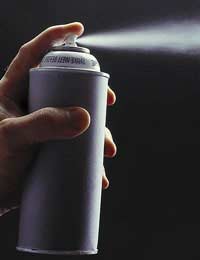Physical Effects of Solvents

The effects experienced from solvent abuse vary greatly depending on the individual, the type of product used, and the amount taken.
What Are Solvents?
Sometimes referred to as ‘glue sniffing’ or more correctly ‘volatile substance abuse’, this type of addiction describes the repeated inhalation of substances such as aerosols (particularly deodorants), glues, lighter fuel, paints, paint thinners, some cleaning agents, nail varnishes and removers.These products are found in most households and are not thought of as particularly dangerous in their intended capacity, and it’s these factors that allow users to gain access to them without much effort or dishonesty.
The products mentioned all emit vapours that are inhaled deep into the lungs via the nose or mouth using a bag, a soaked piece of material or by directly inhaling the product from the packaging it’s sold in.
Physical Effects
The initial effects felt from inhaling a volatile substance are increased confidence, mind-alteration and a general feeling of intoxication.The most severe effect of solvent abuse is death. This can occur for a number of reasons and can happen following a singular dose and to a first-timer.
Causes of Death
As the effects of inhaling solvents can cause intoxication of a similar nature to alcohol, inhibitions are lowered and confidence can grow. This causes users to be more reckless and take risks leading to accidents, some fatal.Suffocation can occur if other paraphernalia is used such as polythene or bags. The user can inhale it as they reach their ‘high’ or pass out with their face embedded in the plastic.
Suffocation can also be the result of squirting the contents of an aerosol can directly into the mouth as the airway can freeze and prevent the person from breathing properly.
This level of intoxication can cause the individual to vomit, sometimes if the person is losing consciousness or is drowsy, they can choke to death.
The effects of some substances, particularly lighter fuel, can cause arrhythmias of the heart (irregular beating), and can lead to cardiac arrest.
Other Effects
Slurred speech, memory loss, being unstable on their feet and headaches are all common side-effects of volatile substance abuse and can easily be confused for drunkenness.An obvious sign of ongoing solvent abuse is a very noticeable rash and spots around the nose and mouth; this can become permanent in long-term users.
Long-term use can also lead to liver, kidney, heart and brain damage, some of which can be irreversible. Also seen in long-term users is depression due to the substances effects on the central nervous system, involuntary muscular movements and problems with fertility.
Nausea, vomiting and dizziness are all often felt by inexperienced users.
Hallucinations have been reported by some users, and these can be either euphoric experiences or be quite frightening.Most ‘hits’ carry an immediate high lasting a few minutes, with lasting effects of up to 45 minutes, when another fix is needed, this leads to a dependency and tolerance that will require the user to inhale larger and more frequent doses.
As with many addictions, mood swings, irritability, changes in appetite and sleep pattern and aggression are all likely to occur in long-term and fully addicted people.
- Step-By-Step Brain Path to Addiction
- Overcome an Addiction to Plastic Surgery
- Mental Health and Addictions
- Addiction and the Law
- The Relationship Between Addiction and Crime
- Addictions Through History
- Drug Addiction in Britain
- Risks of Injecting Substances
- Addictive Personalities
- How Stress Can Lead to Addiction
- Pseudoaddiction and Misinterpretation of Symptoms
- How Does Addiction Affect Peoples' Minds?
- Physical Dependence on a Drug or Substance
- What are the Risk Factors of an Addiction?
- What is Codependency?
- Physiological Effects of Addiction
- The Role of Genetics in Addiction
- Involuntary Addiction to Prescribed Drugs
- Physical Effects of Alcohol
- Physical Effects of Nicotine
- Physical Effects of Opiates
- Physical Effects of Tranquillizers
- What is an Addiction?
- Recognising You Have an Addiction
- The Social Effects of Addiction
- How Do Addictions Start and What Causes Them?


Re: Addiction to Shopping
Hi, I came to realize that I have shopping addiction and it’s getting out of control. I need help but I don’t know where to start. I would…
Re: Beating an Addiction to Pornography
I am in a long term relationship and have a fulfilling sexlife, but i struggle with porn, i feel the need and temptation…
Re: Offering Support to an Addiction Sufferer
My big sister died of a brain tumor then 6 week later my mum went too . I have multiple myeloma and am terminal.…
Re: Addiction to Shopping
I am now at my whits end, my husband is spending money like it has gone out of fashion, and now i am homeworking, I take in the deliveries…
Re: How to Assess The Level of an Addiction
Over a series of many years I have discovered that I have an addicted personality, it has never worried me too much…
Re: How to Assess The Level of an Addiction
Over a series of many years I have discovered that I have an addicted personality, it has never worried me too much…
Re: Offering Support to an Addiction Sufferer
I am an addict and I have just separated from my husband of 16 years as we together developed a cocaine problem.…
Re: Recognising Alcohol Addiciton
Ever since I can remember, I've always overindulged before/during social events. It's got to the point where I've been hateful to…
Re: Beating an Addiction to Chocolate
I suffer from anxiety and mild depression. As a stay at home mum I find myself bored sometimes and truthfully stressed. My…
Re: Offering Support to an Addiction Sufferer
Hi im dpeaking on behalf of my partner , who has a bad alcohol addiction..And this has been going on for neaely…